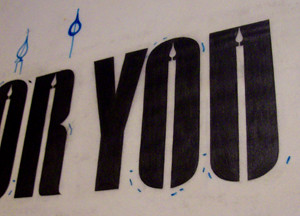A buddy recently gave me a DVD of a documentary that I love: Helvetica. It is about the history and cultural impact of the seminal typeface. And I dig the soundtrack, too. (El Ten Eleven.)
Typeface. That's what we called it back in the day, when I was in college in the '80s. I mean, I seldom used the word "font." At least, not until I was more familiar with computers.
These days, if conversational topics drift into college days, people always raise a quizzical eyebrow if I mention that my most difficult course was not chemistry or microbiology or theoretical physics (okay, I didn't take that last one...it just helped make my point). The most difficult, absorbing class I took was called BASIC TYPE.
A designer drove to the university campus once a week, and for four hours each Tuesday evening, I did my best to impress -- or at least not offend. We drew letters. With nary a computer in the room. We drew typefaces with pencils and worked to tighten hand skills, living for x-heights and serifs and descenders and such.
This was in the days when not everyone had a computer. In fact, most people didn't. And available computer programs didn't make typeface usage and design more accessible to the population. If you wanted something, if you had a vision, you drew it.
Our first assignment was both specific and broad in its parameters. We had to draw two boxes. The border for each box had specific weight (or width), with the top and sides being different than the bottom border. But, each box's border had different dimensions from the other box. Inside the left box was a body part. Inside the right box was a typeface.
Students asked for clarification: "Do you want words? Or just letters?" "Should the body part relate to the word or typeface?" "Does there need to be a physical resemblance between the body part and the letter?"
The instructor wouldn't say. He simply explained that he wanted to see what we would do.
This is what I did.

My critique went okay when compared to the thrashing that many students received. Two girls left the room crying. Four people dropped the course.
The instructor told us that we had to have the skill, not just the will.
I think he meant that just because you liked to doodle during your math lecture in high school didn't mean you should become an art major. Or, more specifically, you may not have what it takes to make it. Just because you liked the artsy crowd and the image of the crowd, you weren't automatically gifted with talent.
My first big project used Railroad Gothic.
I spent many, many hours each week hunched over my drafting table, leaning in close to the vellum to examine curves and edges and intimate areas of negative space. I was always very pleased that I didn't fail that class. But, it did help me understand that perhaps my destiny wasn't to become a designer or professional illustrator.

Mark-ups of an early effort.

More mark-ups of a version with the candles in place

A reverse Photostat of the phrase.
Nice that you still have these samples from another life.
ReplyDeletePaul, the eye is so beautiful... And I really like the candles!
ReplyDeleteLove this!
ReplyDelete